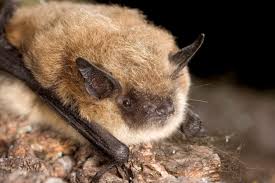
Image by batcon.org
The Yuma myotis is found throughout western North America, from British Columbia through Washington, Idaho, and western Montana, southern Wyoming, Colorado, New Mexico, West Texas and into Mexico. Occasionally roosting in mines or caves, these bats are most often found in buildings or bridges. Bachelors also sometimes roost in abandoned cliff swallow nests, but tree cavities are likely the original sites for most nursery roosts. These bats typically forage over water in forested areas.
A study in western Oregon showed that the feeding activity of Yuma myotis was up to eight times higher along forested edges of streams compared to those in logged areas, apparently because the wooded areas contain greater insect diversity. Although Yuma myotis feed predominantly over water, they eat a variety of insects that includes moths, froghoppers, leafhoppers, June beetles, ground beetles, midges, mosquitoes, muscid flies, caddisflies, and crane flies. Yuma myotis are threatened by loss of riparian habitats and the decline in permanent water sources in the southwest.
Myotis yumanensis
Vespertilionidae
Least Concern
Insectivore
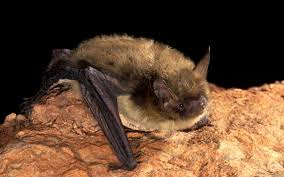
Image by batcon.org
Diet: Northern long-eared bats feed on a variety of insects, including moths, beetles, flies, ants, and true-bugs. They capture prey both in the air and off of surfaces, and commonly feed on spiders by gleaning them from their webs.
Fun Fact: When it comes to hunting moths, northern long-eared bats have an advantage. Even moths that are able to hear (tympanate moths) have a hard time hearing the soft, high frequency calls of this bat. This helps the northern long-eared bat sneak up on both resting and flying moths.
Appearance: Northern long-eared bats are usually brown to light brown in color and weigh between 5-8 grams. Their ears are longer than other similar-sized Myotis species, reaching past the nose when pushed forward. They also have longer tails and broader wings than related species, allowing them to be more maneuverable in flight.
Habitat: This bat prefers to roost in tree cavities, crevices and under exfoliating bark. Snags (standing dead or dying trees) are particularly important for this species, though they will also use artificial bat boxes. During the summer, female bats use roost networks, frequently switching between a collection of different tree roosts.
Northern long-eared bats hibernate during the winter, usually in caves or abandoned mines. Bats generally return to the same hibernaculum each year. They often share hibernacula with other hibernating species including Little Brown Bats, Big Brown Bats, and Tricolored Bats.
Conservation Concerns: Major threats against the northern long-eared bat include habitat loss, human disturbance, and white nose syndrome. Populations are estimated to have declined by at least 90% in the last ten years due to white-nose syndrome alone. The bat was listed as Threatened under the U.S. Endangered Species Act in 2015 and up-listed to “Endangered” in November 2022 (in effect starting March 31, 2023).
Myotis septentrionalis
Vespertilionidae
Near Threatened
Endangered
Insectivore
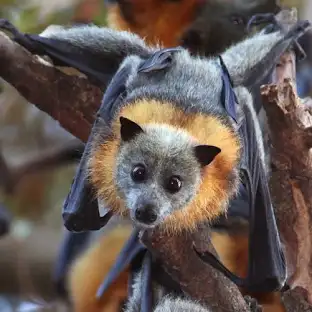
Image by batcon.org
Grey-headed flying foxes drink nectar and eat pollen, fruits, and sometimes leaves from a wide variety of trees including gum trees, eucalyptus, melaleucas, banksia, citrus, coffee, and figs. In doing so they contribute to pollination and seed dispersal.
Fun Fact: The grey-headed flying fox makes multiple types of social vocalizations that are used to communicate in situations related to conflict or reproduction.
Appearance: Grey-headed flying foxes have a grey head, a rusty collar region, a dark grey body with black wings, and leg fur that extends to the ankles. This large species weighs between 650 and 1000 grams and has a wingspan of over 1 meter.
Habitat: Grey-headed flying foxes inhabit subtropical forests, woodlands, swamps, mangroves, agricultural areas, and urban settings. They roost in exposed tree branches in the canopy. Roosting groups may include up to hundreds of thousands of bats in aggregations called camps that change location according to food availability.
Conservation Concerns: The grey-headed flying fox is currently listed as Vulnerable by the IUCN. These bats are threatened by habitat loss and climate extremes that restrict access to foraging and roosting resources. Conflict with people is also a threat as bats move into agricultural and urban areas.
Pteropus poliocephalus
Pteropodidae
Vulnerable
Australia
Frugivore Nectarivore
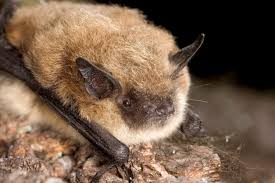
Image by batcon.org
The cave myotis forms nursery colonies, usually numbering in the thousands, in caves, mines, barns, buildings, and sometimes under bridges. It is found throughout the U.S. southwest, from central Oklahoma and Texas westward through the southern half of New Mexico and Arizona.
Cave myotis are aerial insectivores and feed on a wide variety of insects including moths, weevils, antlions, small beetles and flying ants. Because these bats congregate in large groups, they are very susceptible to human disturbance.
Myotis velifer
Vespertilionidae
Least Concern
Insectivore
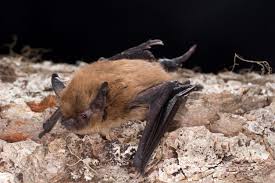
Image by batcon.org
The California myotis ranges throughout western North America, from southern Alaska south into Guatemala, and is one of the most abundant bats in desert scrub habitats. It also can be found in oak and ponderosa pine woodlands. Throughout its range, it roosts beneath loose bark and in crevices of old dead and dying trees. It also forms small maternity colonies in cliffs, buildings, and bridges.
Like many species, California myotis switch roosts on a regular basis, sometimes within a few feet, sometimes up to a mile apart. Roost-switching may aid the bats in finding ideal roost temperatures and avoiding predators and parasites. In most cases, roosts are located near feeding areas.
These bats are among North America’s smallest, enabling them to feed on especially tiny insect prey. It was not until miniature radio transmitters could be outfitted to weigh less than half a gram that these bats could be tracked and their roosts identified.
Myotis californicus
Vespertilionidae
Least Concern
Insectiovore
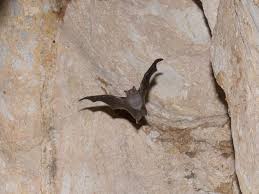
Image by batcon.org
Diet: Bumblebee bats capture their prey in the air using their mouth, feeding on small arthropods like beetles, flies, and even spiders.
Fun Fact: With a body length of only about one inch and weighing less than 2 grams, the bumblebee bat is one of the smallest species of mammal.
Appearance: In addition to their small size, bumblebee bats also have distinctive pig-like noses (hence their other common name Kitti’s Hog-nosed Bat). They are generally brown to brownish-red in color.
Habitat: Bumblebee bats have a very limited geographic range and are found only among limestone caves along the Thailand-Myanmar border. They have very small home ranges, ranging only about one kilometer from their roost to hunt.
Echolocation: These bats can produce extremely fast echolocation calls as they close in on prey, calling as much as 220 times per second. Their echolocation calls usually range between 70 – 80 kHz, with Thai populations having significantly higher frequency calls than bats in Myanmar.
Conservation Concerns: With few known populations, there is limited knowledge on the status of the bumblebee bat. Roost disturbance is the main threat to this bat, which comes in many forms including tourism, fertilizer collection, and limestone mining.
Craseonycteris thonglongyai
Craseonycteridae
Near Threatened
Southeast Asia
Insectivore
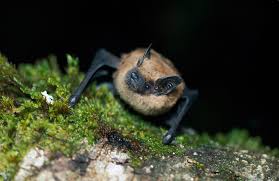
Image by batcon.org
The big brown bat is found in virtually every American habitat ranging from timberline meadows to lowland deserts, though this species is most abundant in deciduous forest areas. It also is often abundant in suburban areas of mixed agricultural use. This species ranges from extreme northern Canada, throughout the United States and south to the extreme southern tip of Mexico. Traditionally, these bats form maternity colonies beneath loose bark and in small cavities of pine, oak, beech, bald cypress, and other trees. Common maternity roosts can also be found in buildings, barns, bridges, and bat houses.
Big brown bats are generalists in their foraging behavior and habitat selections, seemingly showing little preference for feeding over water vs. land, or in forests vs. clearings.Small beetles are their most frequent prey, yet big brown bats will consume prodigious quantities of a wide variety of night-flying insects.
Like all insect-eating bats, big brown bats contribute mightily to a healthy environment and are vital players in pest control. Numerous feeding studies of big brown bats substantiate that they consume significant crop and forest pests including cucumber beetles, ground beetles, scarab beetles, snout beetles and stink bugs, in addition to numerous species of leafhoppers and moths. Like many bat species, reproductive females often can consume their body weight in insects each night. In fact, a colony of 150 big brown bats can consume enough adult cucumber beetles in one summer to prevent egg-laying that could produce 33 million of their root-worm larvae, a major pest of corn crops.
Big brown bats rank among America’s most beneficial animals. As they are forced out of traditional forest habitats due to encroaching human populations, logging, and habitat modification, the bats increasingly move into close human contact and take up residence in buildings and other man-made structures. Bats and humans can coexist peacefully. Sometimes, designing and installing bat-specific artificial roosts is the best option to keep bats out of our homes, yet near enough so that we can continue to benefit from their insect-eating capabilities. Though many species like the big brown bat rank among our most abundant and widespread bats, they nevertheless deserve attention from conservation and education initiatives to assure healthy environments.
Vespertilionidae
Vespertilionidae
Least Concern
Insectivore

Image by batcon.com
IUCN Conservation Status: Near Threatened, Vulnerable
United States Conservation Status: n/a
Diet: Insectivore
With its broad wings, Bechstein’s bat will forage in forests or along forest edges for Lepidoptera, Diptera, Planipennia, and also non-flying insects.
Fun Fact: As a tree roosting bat it is difficult for the whole population to fit in a single roost. Bechstein’s bat demonstrate a ‘fission-fusion’ behaviour where individuals will move between different trees to maintain community bonds with every indiviual within that colony.
Appearance: An average-sized bat with a body mass between 7-14g. It has relatively long and shaggy brown or reddish fur which is paler in young individuals. It has a long-slim muzzle with long and separated ears.
Habitat: This species is typically found in old growth and mature temperate forests and woodlands. It primarily relies on tree holes for roosts (natural features, woodpecker holes etc), but will use bat boxes and occassionally buildings.
Conservation Concerns: Globally, this species is currently listed as ‘Near Threatened’ on the IUCN Red List but within Europe is listed as ‘Vulnerable’ due to loss of mature trees that can support the features that this species relies on for roosts.
Myotis bechsteinii
Vespertilionidae
Near Threatened
Europe
Insectivore